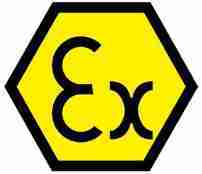ATEX Regulations - Frequently Asked Questions
What are the ATEX Directives?
The term "ATEX" applies to atmospheres that are potentially explosive due to the possible presence of dusts vapours or gases that are likely to ignite or explode.
There are two Directives from the European Commission dealing with this phenomenon.
|
|
Who do these regulations apply to?
The Regulations apply at most workplaces where flammable substances are stored or used, for example, factories where flammable liquids are present or where flammable dusts are produced in the process.
Examples are chemical processing, spraying of paint and varnishes, LPG storage and filling, milk drying, flour production.
What is a flammable substance?
Flammable substance includes any substance or preparation, which because of its properties or the way it is used can cause harm to people from fires and explosions.
Examples of flammable substance are: petrol; liquefied petroleum gas (LPG); paints; varnishes; solvents; and dust which when mixed with air could cause an explosive atmosphere, for example, dust from milling and sanding operations. Flammable substances can be found, in varying quantities, in most workplaces.
What is an explosive atmosphere?
An explosive atmosphere is an accumulation of gas, mist, dust or vapour, mixed with air, which has the potential to catch fire or explode. An explosive atmosphere does not always result in an explosion, but if it caught fire, the flames would quickly travel through it. If this happens in a confined space (e.g. in plant or equipment) the rapid speed of the flames or rise in pressure could also cause an explosion.
How can one avoid an explosive or flammable atmosphere?
Technical and organisational measures should be taken to reduce or eliminate the risk from explosive atmospheres and to mitigate the effects from any fire or explosion.
Avoidance of an explosive atmosphere can be achieved by
1.Elimination
- Replacing a flammable substance with a substance or process that totally eliminates the risks.
2.Substitution
- Where total elimination is not possible the flammable substance may be able to be replaced with a less hazardous one possibly with a higher flashpoint i.e. less easily ignited.
3.Control measures:
- Reduce the quantity of the flammable substance used to the minimum.
- Avoid or minimise releases.
- Remove dust deposits (which may catch fire).
- Control releases at source (local exhaust ventilation).
- Avoid adverse conditions (process control).
- Use of gas alarms.
4.Mitigation measures:
Measures should be taken to minimise the effects of an explosion or fire by:
- Prevention of spreading using fire proof materials, fire safety devices etc.
- Reducing the number of employees exposed to a minimum.
- Providing plant and equipment that can safely contain or suppress an explosion, or vent it to a safe place.
What additional requirements apply in place where explosive/flammable atmospheres occur?
- Areas with explosive atmospheres occur should be classified into zones based on their likelihood and persistence.
- These places should be protected from ignition sources by selecting equipment and protective systems which meet the requirements of the ATEX Product Regulations, although, equipment already in use before July 2003, can continue to be used provided the risk assessment shows that it is safe to do so.
- Where necessary places classified into zones are marked with a specified "Ex "sign at entry points.
- Employees working in zoned areas are provided with adequate work clothing that does not create an electrostatic risk.
- Before a workplace is used its safety must be verified by a person/organisation that is competent in the field of explosion protection.
- These requirements come into effect at different times depending on when the workplace was first used.
The Regulations originally allowed a transposition period which has now expired. Therefore, the Regulations now apply to all workplaces.
What are the employer‘s duties under this Directive?
Overall the Regulations clarify the existing requirements to manage fire and explosion risks, and impose some specific requirements, which are described below.
Employers and the self-employed must:
- Carry out a risk assessment of any work activities involving flammable substances.
- Record the findings of the risk assessment in a document called the explosion protection document.
- Provide technical or organisational measures so as to reduce the risk of explosions (as set out in Schedule 2 of the Regulations)
- Provide training to workers who work in places where explosive atmospheres may occur.
- Classify places (according to Schedule 1 of the Regulations) where explosive atmosphere may occur into zones and mark the zones where necessary.
- Select and provide suitable equipment for use in the zones.
- Equipment must be CE marked and in compliance with SI No 230 of 2017 European Union (Equipment and Protective Systems for use in Potentially Explosive Atmospheres) Regulations 2017 (the ATEX PRODUCT Regulations).
What information instruction and training is required for employees?
The Safety, Health & Welfare at Work Act 2005 and the Safety, Health & Welfare at Work (General Application) Regulations 2007 require that employees are provided with all the necessary information, instruction and training on the risks present at the workplace and the preventive and protection measures required. These regulations require in addition:
- Training for workers on precautions and actions needed to safeguard themselves and others from explosions
- Where required by the explosion protection document-
Written instructions for specific work activities
System of permits to work
What are mitigation measures?
In many cases, it is not possible to avoid explosive atmospheres and sources of ignition with a sufficient degree of certainty. Measures can then be taken to limit the effects of an explosion.
Such measures are:
- Preventing fires and explosion from spreading to other plant and equipment or to other parts of the workplace.
- Reducing the number of employees exposed to a minimum.
- Providing plant and equipment that can safely contain or suppress an explosion, or vent it to a safe place.
What is an EPD?
An EPD is an explosion protection document which contains the findings of a risk assessment of any work activity involving flammable/or explosive atmospheres. It may be incorporated or at least referenced in the Safety Statement, be part of other risk assessment documentation or included in the Safety Report for those establishments subject to the European Communities (Control of Major Accident Hazards Involving Dangerous Substances) Regulations.
It must detail:
- Technical or organisational measures so as to reduce or prevent the risk of explosions (as set out in Schedule 2) and measures used to mitigate the effects of an explosion.
- The operation of early warning devices.
- Training instruction and supervision given to workers who work in places where an explosive or flammable atmosphere may occur.
- Operational procedures, maintenance, operation of permits to work, and co-ordination between employers.
- Classified places (according to Schedule 1) where explosions may occur called hazardous zones and detail marking of areas as well as location.
- Means of escape in the event of an explosion.
- The properties of substances that present an explosion hazard.
- Selection and use of suitable equipment for use in hazardous zones including certification and calibration documents.
- Equipment used that is CE marked and in compliance with SI No 230 of 2017 European Union (Equipment and Protective Systems for use in Potentially Explosive Atmospheres) Regulations 2017 (the ATEX product Regulations).
- How often the EPD is reviewed and when is it due to be reviewed again.


